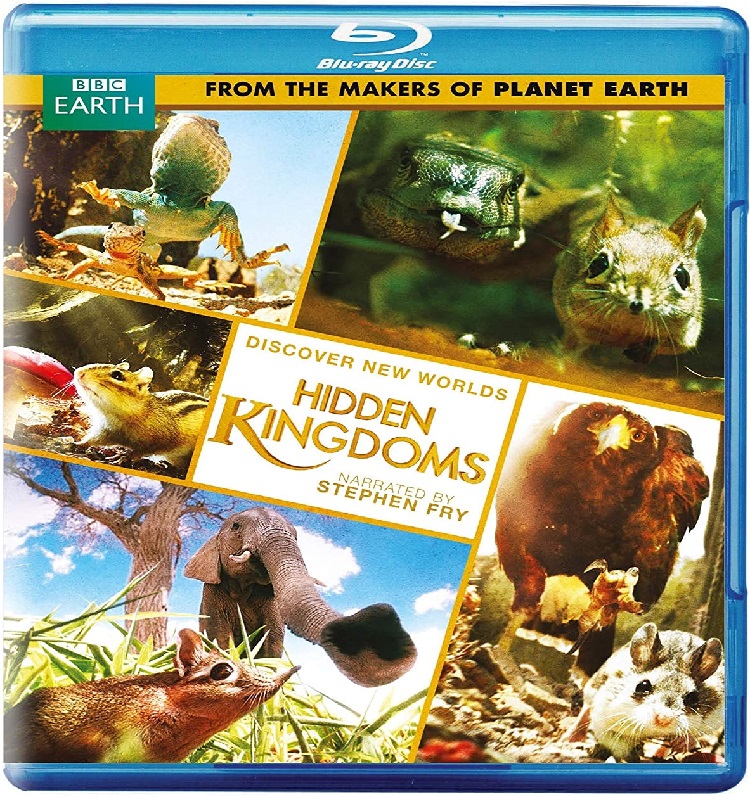
Nature shows have to balance the nature with the show. The point of watching animals do stuff is to see what animals really do, but an hour of just watching a dung beetle shove dung around is not going to be scintillating television. Hidden Kingdoms, a three-part nature show focusing on tiny animals (which played on the Discovery Channel under the much less elegant title Mini Monsters) goes headlong into show and contrivance, creating little manufactured narratives about its stars, complete with twists and motivations that might be a little more complex than these little animal brains can plausibly conceive.
Each episode of Hidden Kingdoms, narrated by Stephen Fry, jumps back and forth between two settings, each with a specific “protagonist” animal whose adventures we follow. Episode one features an African elephant shrew and an Arizona grasshopper mouse; episode two goes to the forests for a tree shrew and a North American chipmunk; the third episode details a marmoset in Rio de Janeiro and a Japanese rhino beetle in Tokyo. These guys each have detailed little stories, involving being cut off from home, searching desperately for food, avoiding predators, and all the kinds of things we see in nature shows.
The difference here is that they are all fictional. These stories are not dispassionately observed, but completely invented. Thankfully, though it’s not directly stated at the outset, the contrivance is completely unconcealed: each episode contains a 10 minute behind the scenes featurette directly after the episode discussing the difficulties of getting the appropriate footage. In these features, the filmmakers are very upfront about the use of compositing, blue screens, combining shots, and creating environments for the animals to interact in.
Which doesn’t mean the stories are implausible, or not scientifically accurate. No animals talk, there are no incredible journeys with real-life enemies hanging out. The intent of these stories is not to deceive, it is the way the filmmakers (and each episode was directed by a different team) determined they could best approach their subjects.
Filming little things is very hard. At that small size, depth of field is usually very shallow – showing prey and predator in motion and in focus can be just optically impossible – as well as ethically questionable, if one is putting animals in peril for a contrived story, rather than just observing the natural order of things – big fish eating the little ones. Some of the behind the scenes footage shows shots of the animals in non-controlled environments – they fly by too quick to be seen, into closed off and delicate environments that can’t be examined without being destroyed in the process.
And, while I personally am much more oriented to the by the books natural historian perspective – I just want to see animals doing things, and don’t deeply care about a marmoset’s first night alone in the city – all the aspects of these episodes that I do not like pale in comparison to the incredible footage. This is a beautiful show, as all the BBC Earth productions are (the BBC Unit responsible for Planet Earth and Life, amongst other nature shows). But what makes this one especially gorgeous is just how close the cameras get to animals that are rarely seen in this detail. I found this especially fascinating when it deals with animal with which I am familiar. A crow’s attempt to find and devour the rhino beetle is some terrific horror filmmaking. All the close up features of the bird – the claws, the eyes, that razor beak, look like something completely alien and terrible shown close-up. Sometimes it looks so good, and detailed, that it’s hard to believe it’s not fake. But no CGI team, no matter what budget, could design anything that looks and moves as wonderfully as these real animals.
Where the contrivance does become distracting, for me, is in the sound design. Most sound design in nature movies is fake or re-recorded. That’s understandable – nature doesn’t wait for a sound check, and shows need good sound. But Hidden Kingdoms goes all the way into fantasy. When there is a rhino beetle fight (and there are several) the sounds of clashing swords are played when the rhinos hit horns. When a jumping spider is shown cleaning his eyes, little rotors sound, like the spider is some kind of mechanical camera. I understand why this is done. It’s color. It’s flavor. It’s spice. I don’t like it.
But there is much about Hidden Kingdoms to like. The stories do not appeal to me, but the magnificent footage does. Some of the motion and timing of the animals can look odd, but that is due to the necessity of shooting at much more than 30 frames per second. Small animals move quickly, and their movements cannot necessarily be captured at standard speeds. They are essentially shot in slow motion just to make them visible… and they are a treat. Whatever issues I have with the narrative and the sound, the incredible shots of small animals in their Hidden Kingdoms cannot be beat.